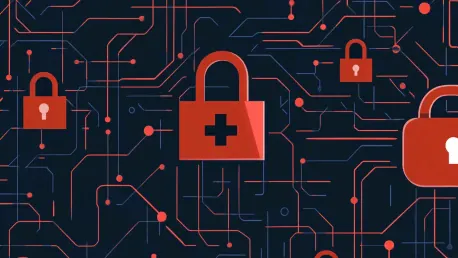In recent years, cybersecurity has emerged as a critical concern for the healthcare sector. With the increasing frequency and sophistication of cyberattacks, healthcare organizations are compelled to reevaluate their cybersecurity frameworks to protect their sensitive medical data. The escalating threat landscape highlights the importance of proactive measures to safeguard against potential breaches. These organizations are not only guardians of patient health but also custodians of valuable medical information that cybercriminals find particularly appealing. The dual role places them squarely in the crosshairs of malicious actors, making cybersecurity a multidimensional challenge that affects every facet of their operations.
Cyberattacks targeting healthcare institutions are growing in number and complexity. The reliance on digital records and interconnected systems makes these organizations prime targets for malicious actors. For instance, a single breach can lead to severe consequences, including compromised patient data, financial loss, and significant reputational damage. Health records contain comprehensive personal information—names, addresses, social security numbers, and medical histories—rendering them a lucrative target. The rise of ransomware attacks, where hackers lock access to vital systems until a ransom is paid, has particularly spurred healthcare institutions to beef up their defenses. Therefore, the escalating threats necessitate a proactive approach to cybersecurity that extends beyond mere compliance to active vigilance and investment.
The Growing Threat Landscape
Healthcare organizations must understand that they are lucrative targets for cybercriminals due to the valuable nature of the medical and personal data they hold. The burgeoning digitization, while making patient care more efficient, has unfortunately also opened avenues for cyber exploitation. Ransomware, phishing attacks, and insider threats represent a trifecta of risks that healthcare providers must contend with regularly. Moreover, the advent of the Internet of Things (IoT) in healthcare—seen in devices like pacemakers and insulin pumps—introduces new potential vulnerabilities that require meticulous cybersecurity protocols.
The sophistication of these attacks has increased dramatically. Cybercriminals now leverage machine learning and artificial intelligence to orchestrate more effective and harder-to-detect cyber offenses. This evolution in threat capability demands an equally advanced defense mechanism. Healthcare providers are compelled to adopt state-of-the-art cybersecurity measures, which include intrusion detection systems, advanced encryption protocols, and continuous monitoring tools. As the frequency and intensity of cyberattacks continue to rise, the healthcare sector’s commitment to cybersecurity must also scale proportionally. The stakes couldn’t be higher: a successful cyberattack could disrupt essential healthcare services, leading to dire consequences for patient health and safety.
Cultivating a Cybersecurity Culture
Andrew Molosky, CEO of Chapters Health System, emphasizes the importance of fostering a cybersecurity-aware culture within organizations. Molosky argues that cybersecurity awareness should be ingrained in the organizational ethos, paralleling its importance to clinical and operational protocols. This entails making every employee, from top executives to entry-level staff, cognizant of the potential cyber threats and the critical role they play in mitigating these risks. It is a collective responsibility wherein the organization’s cybersecurity posture is only as strong as its weakest link.
Continuous training is vital. By regularly educating staff on how to recognize phishing attempts and other common cyberattacks, healthcare organizations can significantly reduce their vulnerability. An ongoing training regimen must be an integral part of the employee onboarding process and regularly updated to reflect the latest threat landscapes. Establishing clear protocols and response plans for potential attacks also helps cultivate a resilient organizational structure capable of responding swiftly and effectively. Molosky’s vision of a cybersecurity-aware culture transcends departmental boundaries, emphasizing that effective cybersecurity demands active participation from everyone in the organization.
Integrating Technology with Security in Mind
Adopting new technologies in healthcare brings numerous benefits, such as improved patient care and operational efficiencies. However, these advancements also introduce new vulnerabilities that cybercriminals can exploit. John Mowery, Chief Information Security Officer at Houston Methodist, advocates for a security-first mindset when integrating new technologies. Each new technological innovation must undergo rigorous security evaluations to uncover potential vulnerabilities before being deployed.
Healthcare providers must ensure that cybersecurity measures are embedded from the onset of technological deployment. This proactive approach requires involving cybersecurity leaders early in the innovation process, ensuring that new tools are scrutinized for potential security flaws before they become operational. Regular audits and updates of existing systems are also crucial in maintaining a robust security posture. Indeed, the speed of technological advancements means that yesterday’s secure system could quickly become tomorrow’s vulnerability if not continually assessed and updated.
The Role of Diverse Leadership
Bringing fresh perspectives into the cybersecurity leadership can tremendously enhance an organization’s defenses. Ben Schwering, Chief Information Security Officer at Premier, encourages healthcare institutions to diversify their leadership by hiring professionals from various industries. Traditional hiring criteria often prioritize extensive healthcare experience, but Schwering argues that leaders with backgrounds in fields such as finance, technology, or even law enforcement can provide unique insights into threat detection and mitigation strategies. These diverse experiences foster innovative solutions to complex cybersecurity problems.
Leaders from varied industries can uncover vulnerabilities that may be overlooked by those entrenched in the healthcare sector. For instance, a Chief Information Security Officer with a background in finance might offer valuable insights into data encryption, inspired by financial sector protocols. Similarly, someone with law enforcement experience could bring in exceptional incident response skills. This broader talent pool can infuse new thinking into the organization, bolstering its overall cybersecurity posture. Schwering’s approach advocates for diversified problem-solving techniques, which can lead to more robust and adaptive cybersecurity strategies.
Financial Investment in Cybersecurity
The conversation around cybersecurity also involves substantial financial commitments. Healthcare entities are realizing that the costs associated with cyberattacks, both in terms of direct financial loss and reputational damage, far exceed the investments needed for preventative measures. Consequently, many healthcare organizations are increasing their cybersecurity budgets. This financial shift underscores an emerging consensus: proactive investment in cybersecurity is not an optional expense, but a necessary one.
Allocating resources to advanced security tools, such as encryption, multi-factor authentication, and intrusion detection systems, is becoming standard practice. Moreover, investing in cybersecurity insurance policies can provide additional layers of protection, ensuring that organizations are financially resilient in the event of an attack. This financial commitment reflects a broader understanding that a successful cyber defense strategy necessitates both advanced technological tools and the financial resources to sustain them. As cyber threats continue to evolve, so must the fiscal strategies designed to counter them, balancing immediate cybersecurity needs with long-term resilience planning.









